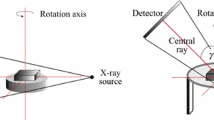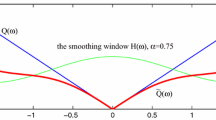Abstract
Conventional X-ray tomography is an effective tool of medical diagnostics, nondestructive testing of engineering structures, and technical diagnostics of manufactured products. Tomographic reconstruction of objects is a strongly incorrect inverse problem in the case of limited vision angle, small number of projections, and/or insufficient X-ray source energy. Hull and hull-voxel methods of tomographic reconstruction of piecewise-uniform objects are considered in this paper. These approaches are quite effective for image reconstruction of industrial and biological objects under conditions of sparse input data and for analyzing binary and piecewise-uniform images. It will be a priori assumed that the object being reconstructed consists of areas with constant attenuation coefficients.
Similar content being viewed by others
References
F. Natterer, The Mathematics of Computerized Tomograthy (Stuttgart, 1986).
W. H. Press, S. A. Teukolsky, W. T. Wetterling, and B. P. Flannary, Numerical Recipes in C (Univ. Press, Cambridge, 1992).
A. Tichonov, V. Leonov, and A. Yagola, Nonlinear Ill-Posed Problems (Kluwer Acad. Publ., 1997).
K. T. Smith, D. C. Solomon, and S. L. Wagner, “Practical and Mathematical Aspects of the Problem of Reconstructing Objects from Radiographs,” Bull. AMS 83, 1227–1270 (1977).
S. Siltanen, V. Kolehmainen, S. Jaervenpaa, J. P. Kaipio, et al., “Statistical Inversion for X-ray Tomography with Few Radiographs. I: General Theory,” Phys. Med. Biol. 48, 1437–1463 (2003).
K. M. Hanson, “Bayesian and Related Methods in Image Reconstruction from Incomplete Data,” in Image Recovery: Theory and Applications, Ed. by H. Stark (Academic, Orlando, 1987), pp. 79–125.
K. Mosegaard and M. Sambridge, “Monte Carlo Analysis of Inverse Problems,” Inverse Problems 8, 29–54 (2002).
K. M. Hanson, G. S. Cunningham, and R. J. McKee, “Uncertainty Assessment for Reconstruction Based on Deformable Geometry,” Int. J. Imaging Syst. Techn. 8, 506–512 (1997).
J. Besag, “Spatial Interaction and the Statistical Analysis of Lattice Systems,” J. Roy. Stat. Soc. 36, 192–236 (1974).
D. L. Donoho, I. M. Johnstone, J. C. Hoch, and A. S. Stern, “Maximum Entropy and the Near Black Object,” J. Roy. Stat. Soc. B 54(1), 41–81 (1992).
J. R. Thompson and R. A. Tapia, Nonparametric Function Estimation Modeling and Simulation (SIAM, Philadelphia, PA, 1990), pp. 214–226.
J. P. Kaipio, V. Kolehmainen, M. Vauhkonen, and E. Somersalo, “Inverse Problems with Structural Prior Information,” Inverse Problems 15, 713–729 (1999).
G. K. Nichols and C. Fox, “Modeling and Posterior Sampling in Impedance Imaging,” Proc. SPIE Bayesian Inference Inverse Probl. 3459, 116–127 (1998).
V. Vengrinovich, S. Zolotarev, A. Kuntsevich, and G.-R. Tillack, “New Technique for 2D an 3D X-Ray Image Restoration of Pipes in Service Given a Limited Access for Observation,” in Review of Progress in QNDE, Ed. by D. O. Tompson and D. E. Chimenti (American Institute of Physics, Melville, NY, 2001), Vol. 20A, pp. 756–763.
Author information
Authors and Affiliations
Corresponding author
Additional information
Valerii L’vovich Vengrinovich. Born 1939. Graduated from Kiev Polytechnic Institute in 1961. Received candidate’s degree in 1975 and doctoral degree in 1990. Head of the Laboratory of Computerized Diagnostics at the Institute of Applied Physics of the National Academy of Sciences of Belarus. A recognized scientist in the field of nondestructive testing in mechanical engineering, physics of magnetic phenomena, and computerized diagnostics. Scientific interests: physics of micromagnetic effects, Barkhausen effect and its industrial applications, X-ray computerized limitedview tomography of industrial and biological objects. Author of more than 300 scientific papers, with two monographs, 50 inventor’s certificates, and more than 60 papers in leading foreign journals.
Sergei Alekseevich Zolotarev. Born 1956. Graduated from Voronezh Institute of Technology in 1978. Received candidate’s degree in 1992 and doctoral degree in 2010. Chief researcher in the Laboratory of Computerized Diagnostics at the Institute of Applied Physics of the National Academy of Sciences of Belarus. Scientific interests: computerized diagnostics and computerized limitedview tomography of industrial and biological objects. Author of more than 70 scientific papers, with a monograph, an inventor’s certificate, and a patent.
Rights and permissions
About this article
Cite this article
Vengrinovich, V.L., Zolotarev, S.A. Hull-voxel reconstruction of images as a means of structural analysis. Pattern Recognit. Image Anal. 23, 145–152 (2013). https://doi.org/10.1134/S1054661813010124
Received:
Published:
Issue Date:
DOI: https://doi.org/10.1134/S1054661813010124




